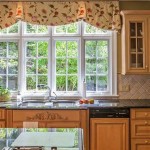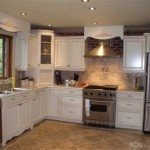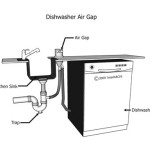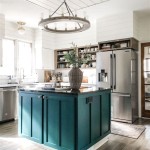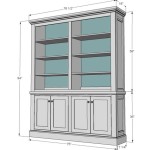Optimizing Kitchen Door Knob Location: A Guide to Ergonomics and Functionality
The strategic placement of door knobs in a kitchen environment is a crucial aspect of design, impacting both functionality and user experience. An improperly positioned door knob can lead to awkward movements, potential safety hazards, and an overall diminished sense of efficiency within the workspace. This article aims to provide a comprehensive understanding of the factors influencing optimal kitchen door knob location, focusing on ergonomic considerations, accessibility standards, and aesthetic integration.
The standard practice for door knob height in residential settings typically ranges from 34 to 38 inches (86 to 97 cm) from the finished floor. This range generally accommodates the average adult's reach and allows for comfortable operation. However, in the context of a kitchen, several variables necessitate a more nuanced approach to determine the ideal placement.
Considering User Anthropometrics and Ergonomics
Anthropometrics, the scientific study of human body measurements, plays a significant role in determining optimal door knob height. The average height of kitchen users should be taken into account, as a door knob placed too high can be difficult to reach for shorter individuals, while a knob placed too low may require taller individuals to stoop or bend uncomfortably. The concept of ergonomic design emphasizes minimizing strain and maximizing efficiency by tailoring the environment to the user's physical capabilities. When positioning kitchen door knobs, the goal is to facilitate a natural and effortless interaction, reducing the risk of repetitive stress injuries and promoting overall comfort.
Furthermore, the typical tasks performed in the kitchen should be considered. Are users frequently carrying items while opening doors? If so, a slightly lower door knob position might be preferable, allowing for easier operation with an elbow or forearm. Conversely, if the door leads to a pantry where access to high shelves is common, a standard height might be more appropriate to maintain a consistent posture throughout the task.
The force required to operate the door also impacts the optimal knob location. A heavy door or one with a strong closing mechanism necessitates a more secure grip, which is often facilitated by a standard height placement. Lighter doors, on the other hand, offer more flexibility in terms of knob height adjustment.
In houses that consist of people with varying physical capabilities, such as children and adults, or people with disabilities, the kitchen door knob location must cater to accommodating these variations.
Adhering to Accessibility Standards and Guidelines
Accessibility standards, such as those outlined in the Americans with Disabilities Act (ADA), provide specific guidelines for door hardware placement to ensure inclusivity for individuals with mobility impairments. While the ADA primarily focuses on public spaces, many principles are applicable to residential kitchens, particularly when designing for aging in place or accommodating family members with disabilities.
According to ADA guidelines, operable parts of doors, including door knobs, should be mounted no higher than 48 inches (122 cm) above the finished floor and no lower than 34 inches (86 cm) above the finished floor. This range accommodates individuals using wheelchairs or other mobility devices, allowing them to reach and operate the door knob without excessive stretching or bending. It is necessary to understand that some kitchens have different types of doors and door knobs.
Beyond height requirements, accessibility standards also address the ease of operation. Door knobs should be easy to grasp and turn, requiring minimal force. Lever-style handles are often preferred over traditional round knobs, as they offer a more ergonomic grip and can be operated with a closed fist or forearm. Consider the possibility of installing lever-style handles on kitchen doors to improve accessibility, especially for those with limited hand strength or dexterity.
The clear maneuvering space around the door is another critical consideration. Adequate space should be provided on both sides of the door to allow wheelchair users to approach, open, and pass through the doorway without obstruction. This space should be free of obstacles, such as appliances, countertops, or furniture. The width of the doorway also needs to meet accessibility standards, ensuring that wheelchairs and other mobility devices can pass through comfortably.
Integrating Aesthetic Considerations and Design Harmony
While functionality and accessibility are paramount, the aesthetic integration of door knobs should not be overlooked. The door knob's style, finish, and overall design should complement the kitchen's existing décor and architectural style. Selecting a door knob that aligns with the overall aesthetic creates a cohesive and visually appealing environment.
The door knob's placement can also influence the perceived symmetry and balance of the kitchen design. Centering the door knob on the door panel typically creates a visually pleasing and harmonious look. However, in some cases, an off-center placement might be necessary to accommodate structural constraints or design features.
The material and finish of the door knob should also be carefully considered. Common materials include brass, stainless steel, bronze, and glass. The finish can range from polished to matte, and the choice should complement the other hardware and fixtures in the kitchen. For example, if the kitchen features stainless steel appliances, selecting stainless steel door knobs can create a unified and modern look.
The size and shape of the door knob should also be proportionate to the size and style of the door. A large, ornate door knob might be appropriate for a traditional kitchen with heavy wooden doors, while a smaller, minimalist door knob might be more suitable for a contemporary kitchen with sleek, frameless doors. If the kitchen includes an island, the appearance of the island doors must be considered along with the main door.
Ultimately, the optimal kitchen door knob location is a balance between ergonomic considerations, accessibility standards, and aesthetic integration. By carefully considering these factors, homeowners and designers can create a kitchen environment that is both functional, accessible, and visually appealing. Failure to consider these factors can lead to daily inconveniences and safety hazards for the kitchen user.
In cases where multiple users exist, consider a consensus on the height and type of doorknob that will be installed. If a consensus cannot be reached, explore alternative options that may accommodate multiple users.

Design 101 Cabinet Hardware Placement Lark Linen

How To Place Cabinet Knobs Pulls

Tips For Cabinet Hardware Placement Knobs Are Placed Opposite Of Door Hinges Pontis Construction

Kitchen Cabinets Knob Placement Guide

Cabinet Door Hardware Placement Guidelines Taylorcraft Company

Cabinet Hardware Placement Guide

Cabinet Knob Placement Mog Kitchen Bathroom Remodeling Marietta

Cabinet Hardware Placement Diagram Renovated Faith

Cabinet Hardware Installation Guide At Cabinetknob Com

Guide To Cabinet Hardware Placement Farmhouse Kitchen Doors Farmhousekitchencabinetdoo Cabinets Home
Related Posts

